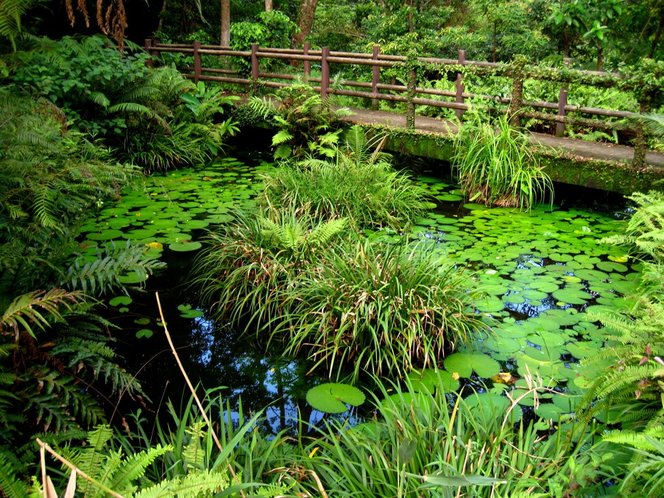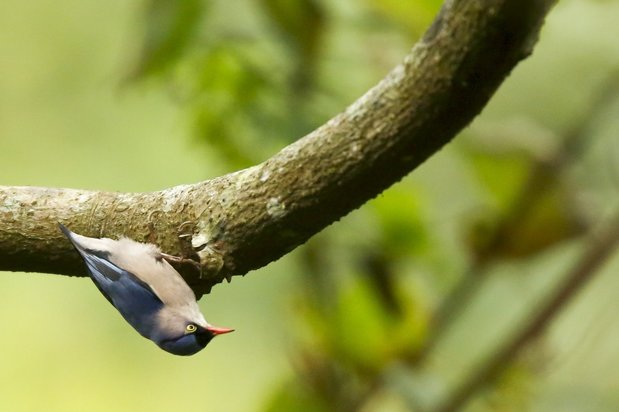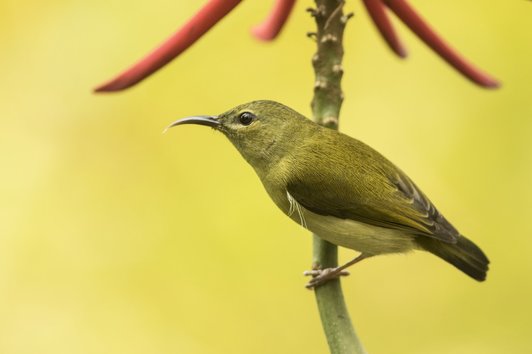TAI PO KAU
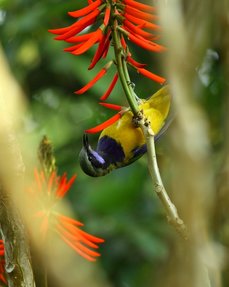 Orange-bellied Leafbird
Orange-bellied Leafbird
The natural vegetation of Hong is broad-leaved, sub-tropical forest; a place where, aeons ago, tigers, elephants and bears roamed and the avifauna would have included pheasants and trogons. This forest was probably all gone well before the 17th century, and most of the animals and birds had disappeared with it.
Reforestation in various areas of Hong Kong – “the barren rock” – began at the end of the nineteenth century as a result of deliberate government policy. The plantation at Tai Po Kau was begun in 1926 –as in other places, the main tree planted was Chinese Red Pine – but, as everywhere else in the territory, the forest was destroyed during the Japanese occupation to provide firewood for the colony.
After the end of the Second World War, the area was replanted with a variety of trees; with exotics such as Brisbane Box, Paper-bark and Taiwan Acacia, as well as a number of species native to South China. The secondary forest at Tai Po Kau is currently just over seventy years old, and the diverse animal life is a reflection of the mature age of the forest – as well as the variety of trees. In fact, this 460-hectare site contains more than 100 species of trees. It was declared a nature reserve in 1977, and is based around the attractive, near-pristine 3.6 km-long Tai Po Kau Forest Stream .
The height of the forest extends from 50 metres above sea level to 650 metres at the top of Grassy Hill (Tso Shan). Over 170 species of birds have been recorded in the reserve. Birds are most numerous during the winter period, but can be frustratingly difficult to see amongst the greenery; expert birdwatchers tend to rely more on their ears than their eyes to tell which species are present. However, with persistence and some luck, it is possible to see a good number of the birds that frequent the forest.
Reforestation in various areas of Hong Kong – “the barren rock” – began at the end of the nineteenth century as a result of deliberate government policy. The plantation at Tai Po Kau was begun in 1926 –as in other places, the main tree planted was Chinese Red Pine – but, as everywhere else in the territory, the forest was destroyed during the Japanese occupation to provide firewood for the colony.
After the end of the Second World War, the area was replanted with a variety of trees; with exotics such as Brisbane Box, Paper-bark and Taiwan Acacia, as well as a number of species native to South China. The secondary forest at Tai Po Kau is currently just over seventy years old, and the diverse animal life is a reflection of the mature age of the forest – as well as the variety of trees. In fact, this 460-hectare site contains more than 100 species of trees. It was declared a nature reserve in 1977, and is based around the attractive, near-pristine 3.6 km-long Tai Po Kau Forest Stream .
The height of the forest extends from 50 metres above sea level to 650 metres at the top of Grassy Hill (Tso Shan). Over 170 species of birds have been recorded in the reserve. Birds are most numerous during the winter period, but can be frustratingly difficult to see amongst the greenery; expert birdwatchers tend to rely more on their ears than their eyes to tell which species are present. However, with persistence and some luck, it is possible to see a good number of the birds that frequent the forest.
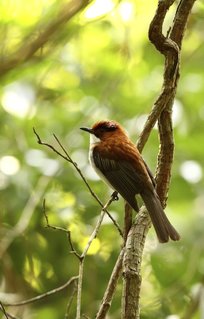 Chestnut Bulbul
Chestnut Bulbul
The question arises that if forest in Hong was virtually non-existent after the Second World War, then where have the current resident woodland birds come from? The following list suggests answers to this question:
1) the moving in of generalist species such as Cinereous Tit, Common Tailorbird and Fork-tailed Sunbird from other local habitats
2) winter visitors staying to breed e.g., Scarlet and Grey-chinned Minivets, Chestnut Bulbul and Orange-bellied Leafbird
3) escaped/released birds: the three obvious well-established species that fit into this category are Velvet-fronted Nuthatch, Blue-winged Minla and Silver-eared Mesia. These birds occur in western China and southeast Asia but are not part of the south China avifauna. These birds are assigned to category IIB on the Hong Kong bird list.
Category IIA is more controversial. These species are a part of the south China avifauna but the population in Hong Kong is regarded as deriving from ex-captive birds. The woodland species involved are: Yellow-cheeked Tit, Streak-breasted Scimitar Babbler, Rufous-capped Babbler, Huet’s Fulvetta, Greater Necklaced Laughingthrush, Black-throated Laughingthrush and Red-billed Leiothrix. With the recent increase in the number of wild birds colonizing from mainland China, the status of a number of these Category IIA species is perhaps due for reassessment. Indeed, in a recent review of the arrival pattern of forest birds in Hong Kong in HKBWS Bulletin 241, Captain Wong argues that Greater Necklaced Laughingthrush, Red-billed Leiothrix, Streak-breasted Scimitar Babbler and Huet’s Fulvetta fit a pattern of natural colonisation.
4) colonisation from the mainland as a result of the forest maturing. A number of species that were unknown here when I first arrived in the early 1990s have moved in and established themselves as part of the forest avifauna e.g. Brown Wood Owl, Lesser Shortwing, Mountain Tailorbird, Pygmy Wren Babbler, Bay Woodpecker and Speckled Piculet. The latest addition is Chinese Barbet; a single bird was singing regularly along the access road and above the AFCD headquarters in spring 2016.
There has also been an increase in the number of species that are summer visitors to the forest. Hainan Blue Flycatcher and Large Hawk Cuckoo have long occurred, but in recent years Brown-breasted Flycatcher has bred, and Hodgson’s Hawk Cuckoo, Lesser Cuckoo and Fork-tailed Drongo Cuckoo are increasingly heard.
The forest is perhaps most “birdy” during the winter months when, apart from the resident species, birders can hope to see Yellow-browed, Pallas’s and Goodson’s Leaf Warblers, Grey-headed Canary and Verditer Flycatchers, Ashy Drongo, Black-winged Cuckooshrike, Red-flanked Bluetail, Rufous-tailed Robin and a number of thrushes. Various additional flycatchers and warblers also occur on passage.
1) the moving in of generalist species such as Cinereous Tit, Common Tailorbird and Fork-tailed Sunbird from other local habitats
2) winter visitors staying to breed e.g., Scarlet and Grey-chinned Minivets, Chestnut Bulbul and Orange-bellied Leafbird
3) escaped/released birds: the three obvious well-established species that fit into this category are Velvet-fronted Nuthatch, Blue-winged Minla and Silver-eared Mesia. These birds occur in western China and southeast Asia but are not part of the south China avifauna. These birds are assigned to category IIB on the Hong Kong bird list.
Category IIA is more controversial. These species are a part of the south China avifauna but the population in Hong Kong is regarded as deriving from ex-captive birds. The woodland species involved are: Yellow-cheeked Tit, Streak-breasted Scimitar Babbler, Rufous-capped Babbler, Huet’s Fulvetta, Greater Necklaced Laughingthrush, Black-throated Laughingthrush and Red-billed Leiothrix. With the recent increase in the number of wild birds colonizing from mainland China, the status of a number of these Category IIA species is perhaps due for reassessment. Indeed, in a recent review of the arrival pattern of forest birds in Hong Kong in HKBWS Bulletin 241, Captain Wong argues that Greater Necklaced Laughingthrush, Red-billed Leiothrix, Streak-breasted Scimitar Babbler and Huet’s Fulvetta fit a pattern of natural colonisation.
4) colonisation from the mainland as a result of the forest maturing. A number of species that were unknown here when I first arrived in the early 1990s have moved in and established themselves as part of the forest avifauna e.g. Brown Wood Owl, Lesser Shortwing, Mountain Tailorbird, Pygmy Wren Babbler, Bay Woodpecker and Speckled Piculet. The latest addition is Chinese Barbet; a single bird was singing regularly along the access road and above the AFCD headquarters in spring 2016.
There has also been an increase in the number of species that are summer visitors to the forest. Hainan Blue Flycatcher and Large Hawk Cuckoo have long occurred, but in recent years Brown-breasted Flycatcher has bred, and Hodgson’s Hawk Cuckoo, Lesser Cuckoo and Fork-tailed Drongo Cuckoo are increasingly heard.
The forest is perhaps most “birdy” during the winter months when, apart from the resident species, birders can hope to see Yellow-browed, Pallas’s and Goodson’s Leaf Warblers, Grey-headed Canary and Verditer Flycatchers, Ashy Drongo, Black-winged Cuckooshrike, Red-flanked Bluetail, Rufous-tailed Robin and a number of thrushes. Various additional flycatchers and warblers also occur on passage.
GETTING AROUND
The reserve is managed by the AFCD who have established a number of easily followed trails through the forest, as well as picnic areas and an educational Outdoor Study Centre. The walks are colour-coded. The Red Walk is 3 km, the Blue Walk 4km, the Brown Walk 7.5 km and the Yellow Walk 10 km. The Blue Walk leads off from the Red Walk, the Yellow Walk from the Brown Walk. The Brown and Yellow Walks are at a higher elevation than the Red and Blue Walks, and because they have less diversity of trees are generally less productive for animal life than the Red and Blue Walks. Most bird watchers do the Red Walk or the Blue Walk. The walk described below follows the Red Walk but also includes part of the Blue Walk (the Blue Walk loop).
A sketch map of the area can be found here. The walk – for the most part circular - is about five kilometres in length.
Outside of the breeding season, birds tend to wander in mixed parties through the forest so recommending specific areas is difficult. A few spots are referred to in the following account, but successful forest birding is often a matter of persistence and luck.
A sketch map of the area can be found here. The walk – for the most part circular - is about five kilometres in length.
Outside of the breeding season, birds tend to wander in mixed parties through the forest so recommending specific areas is difficult. A few spots are referred to in the following account, but successful forest birding is often a matter of persistence and luck.
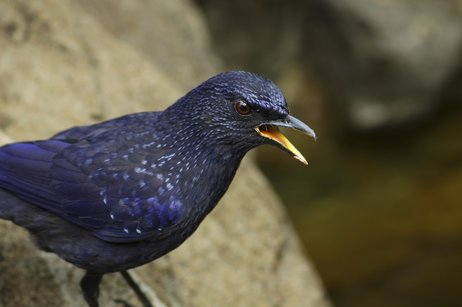 Blue Whistling Thrush
Blue Whistling Thrush
Access to the reserve is at Tsung Tsai Yuen on the Tai Po Road between Tai Po and Sha Tin. There is car-parking next to a small ornamental park replete with tall, feathery Casuarina Trees and flowering shrubs (1). The trees here, especially early in the morning, may hold a number of common forest birds. At the western end of this tiny park next to some toilet booths you can look down onto the rocky Tai Po Kau Stream. This spot can be good for Blue Whistling Thrush.
From the car park, a metalled road takes you uphill (a little steepish in parts, especially at the beginning) to the start of the coloured walks proper. As the road is wide, it provides good views over the trees. Walk past the entrance to the (generally unproductive) Nature Trail (2) and continue along the road. A little further uphill, the area off to your right used to be an orchard, but is now more open and contains an ornamental pond, banana trees and grassy areas. Look out for common open-country birds here such as Long-tailed Shrike in winter. Common Kingfisher sometimes perches on the rocks in the pond. Resident forest birds such as Mountain Tailorbird and Black-throated Laughingthrush sometimes occur in the vicinity, and you may encounter a bird wave containing resident and, in winter, migrants from the north.
Just after the (now unused) Warden Post (3), to do the Red Walk in a clockwise direction, you leave the road to your left and follow the signposted trail. There is an information board next to the signposts and a toilet block a little further along adjacent to a small exercise and picnic area. Before the toilet block, there is a small clump of Rhodeleia trees. These flower in January and February and are then a reliable site for Fork-tailed Sunbird and Orange-bellied Leafbird. A tall Red Cotton Tree next to the toilets can hold the same species when it flowers in February/March.
From the car park, a metalled road takes you uphill (a little steepish in parts, especially at the beginning) to the start of the coloured walks proper. As the road is wide, it provides good views over the trees. Walk past the entrance to the (generally unproductive) Nature Trail (2) and continue along the road. A little further uphill, the area off to your right used to be an orchard, but is now more open and contains an ornamental pond, banana trees and grassy areas. Look out for common open-country birds here such as Long-tailed Shrike in winter. Common Kingfisher sometimes perches on the rocks in the pond. Resident forest birds such as Mountain Tailorbird and Black-throated Laughingthrush sometimes occur in the vicinity, and you may encounter a bird wave containing resident and, in winter, migrants from the north.
Just after the (now unused) Warden Post (3), to do the Red Walk in a clockwise direction, you leave the road to your left and follow the signposted trail. There is an information board next to the signposts and a toilet block a little further along adjacent to a small exercise and picnic area. Before the toilet block, there is a small clump of Rhodeleia trees. These flower in January and February and are then a reliable site for Fork-tailed Sunbird and Orange-bellied Leafbird. A tall Red Cotton Tree next to the toilets can hold the same species when it flowers in February/March.
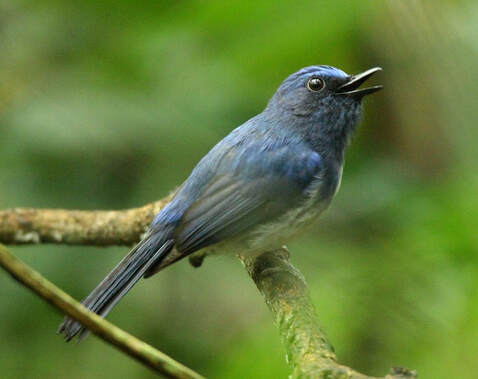 Hainan Blue Flycatcher
Hainan Blue Flycatcher
Just after the Red Cotton Tree, on your right you will see that the stream is dammed. The dam is conspicuous as is the circular catchment tank (4). If you listen carefully from the open area near the catchment tank, you may hear a distant “coo-ee-you” call followed by an answering “ee-ee-ee”. These calls are much-repeated and can persist for several minutes. This duetting chorus is made by the Great Barbet. It is also a good idea to scan the skies over the trees from this point for raptors; both Crested Goshawk and Crested Serpent Eagle are resident in the forest.
The concrete path runs parallel to the stream for a short distance. Steps off to the left take you upwards away from the stream (the steps across the stream lead up to a later section of the Red Walk). Soon the path diverges at a signpost – upwards for the Brown and Yellow Walks (and the end of the Nature Trail), right for the Red and Blue Walks (5). Take the right turn. The path now becomes enclosed by tall trees. The path opens out briefly at the second picnic area (6). Just before the picnic area, the trees often hold singing Hainan Blue Flycatcher from mid-April onwards. This migrant flycatcher breeds in southern China and moves into Indochina in winter. The open picnic area itself is a good place to scan the surrounding trees. Bird waves can sometimes be observed from here. Bay Woodpecker is a rare bird in Hong Kong, but up to three have been reported in Tai Po Kau since 2008 and they are sometimes noted in this area.
As you leave the picnic area, a small bridge takes you over a stream. The forest along this stretch sometimes holds bird waves in winter; in recent years birds present have included the uncommon White-spectacled Warbler and Chestnut-crowned Warbler. Mountain Bulbul seems to be of regular occurrence along here too. You may also hear the plaintive two-or-three note whistle of the tailless Pygmy Wren Babbler as it moves around on the forest floor.
A bridge (7) crosses over the main Tai Po Kau Stream. There is a signpost for the Blue Walk indicating the trail leading off to your left. Continuing on the Red Walk takes you over the stream. The Blue Walk trail actually loops around the stream and reconnects with the Red Walk after steps off the Blue Walk loop lead up to the Blue Walk proper. I usually walk the 800 metres of the Blue Walk loop as it allows for the exploration of more attractive forest.
However, in January/February I often check the grove of Rhodoleia (8) just over the bridge for nectar-loving species and Mountain Bulbul. From the grove, you can either continue up the steps, heading right when you arrive at the junction of the Red Walk with the Blue Walk loop, or return to the other side of the stream and continue along the Blue Walk loop. The loop follows the stream further uphill – the stream is audible, if not always visible, off to your right. Again, you may be lucky enough to come across a bird wave in the trees along the loop.
The concrete path runs parallel to the stream for a short distance. Steps off to the left take you upwards away from the stream (the steps across the stream lead up to a later section of the Red Walk). Soon the path diverges at a signpost – upwards for the Brown and Yellow Walks (and the end of the Nature Trail), right for the Red and Blue Walks (5). Take the right turn. The path now becomes enclosed by tall trees. The path opens out briefly at the second picnic area (6). Just before the picnic area, the trees often hold singing Hainan Blue Flycatcher from mid-April onwards. This migrant flycatcher breeds in southern China and moves into Indochina in winter. The open picnic area itself is a good place to scan the surrounding trees. Bird waves can sometimes be observed from here. Bay Woodpecker is a rare bird in Hong Kong, but up to three have been reported in Tai Po Kau since 2008 and they are sometimes noted in this area.
As you leave the picnic area, a small bridge takes you over a stream. The forest along this stretch sometimes holds bird waves in winter; in recent years birds present have included the uncommon White-spectacled Warbler and Chestnut-crowned Warbler. Mountain Bulbul seems to be of regular occurrence along here too. You may also hear the plaintive two-or-three note whistle of the tailless Pygmy Wren Babbler as it moves around on the forest floor.
A bridge (7) crosses over the main Tai Po Kau Stream. There is a signpost for the Blue Walk indicating the trail leading off to your left. Continuing on the Red Walk takes you over the stream. The Blue Walk trail actually loops around the stream and reconnects with the Red Walk after steps off the Blue Walk loop lead up to the Blue Walk proper. I usually walk the 800 metres of the Blue Walk loop as it allows for the exploration of more attractive forest.
However, in January/February I often check the grove of Rhodoleia (8) just over the bridge for nectar-loving species and Mountain Bulbul. From the grove, you can either continue up the steps, heading right when you arrive at the junction of the Red Walk with the Blue Walk loop, or return to the other side of the stream and continue along the Blue Walk loop. The loop follows the stream further uphill – the stream is audible, if not always visible, off to your right. Again, you may be lucky enough to come across a bird wave in the trees along the loop.
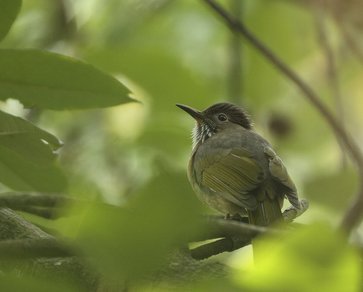 Mountain Bulbul
Mountain Bulbul
At the highest section of the loop, the trail crosses a bridge and heads back towards the Red Walk on the other side of the stream. The route is well signposted. After about 100 metres the trail detours away from the stream. After about 300 metres steps lead up to the Blue Walk (9); again the route is clearly signposted. Do not go up the steps but carry straight on following the sign to the Red Walk and this will shortly bring you to the top of the steps that lead up from the Rhodoleia grove. This stretch is often good for another resident bird, Huet’s Fulvetta, although it tends to be scarcer and less often seen than some of the species already mentioned.
Continue along the Red Walk. The forest is now a little more open. After another 300 metres, there are more steps leading downwards to the right of the path; these steps lead down to the stream between the first and second picnic areas. Keeping on the Red Walk brings you to an attractive area of ferns beside the trail. Further on still, there is an isolated patch of bamboo (10) that can be good for bird species such as Rufous-capped Babbler and Greater-necklaced Laughingthrush. The forest after the bamboo patch often holds wintering thrushes, particularly Grey-backed Thrushes, and you may get a glimpse of them foraging amongst the leaf litter below you on the forest floor. However, they are shy birds and are more often heard than seen.
Not all that long after the patch of bamboo, the trail emerges onto the metalled road, which is called a Forest Track. All the signs from here point downhill. Follow the signs down to the AFCD headquarters. Just past here is the entrance to the Outdoor Study Centre (11), one of the most attractive, relatively recent additions to the forest reserve.
At the entrance there are some small Coral Trees Erythrina sp. In winter, the trees have conspicuous, long, upcurved red flowers in rows on the branches. These flowers attract the same nectar-feeding species as mentioned before for the Red Cotton Tree and Rhodoleia, but here the birds are at eye-level. In particular, the Fork-tailed Sunbird regularly visits the flowers and you can get excellent views of the birds from the road or the wooden steps that lead down into the Study Centre gardens. Again, there is a possibility of a bird-wave in this area.
Leaving the Outdoor Study Centre, you continue left downhill and will soon come to the bottom of the dam which you saw at the start of the Red Walk. From the dam walk back down the access road to the Old Tai Po Road, from where buses or taxis will take you to Tai Po or Sha Tin.
Continue along the Red Walk. The forest is now a little more open. After another 300 metres, there are more steps leading downwards to the right of the path; these steps lead down to the stream between the first and second picnic areas. Keeping on the Red Walk brings you to an attractive area of ferns beside the trail. Further on still, there is an isolated patch of bamboo (10) that can be good for bird species such as Rufous-capped Babbler and Greater-necklaced Laughingthrush. The forest after the bamboo patch often holds wintering thrushes, particularly Grey-backed Thrushes, and you may get a glimpse of them foraging amongst the leaf litter below you on the forest floor. However, they are shy birds and are more often heard than seen.
Not all that long after the patch of bamboo, the trail emerges onto the metalled road, which is called a Forest Track. All the signs from here point downhill. Follow the signs down to the AFCD headquarters. Just past here is the entrance to the Outdoor Study Centre (11), one of the most attractive, relatively recent additions to the forest reserve.
At the entrance there are some small Coral Trees Erythrina sp. In winter, the trees have conspicuous, long, upcurved red flowers in rows on the branches. These flowers attract the same nectar-feeding species as mentioned before for the Red Cotton Tree and Rhodoleia, but here the birds are at eye-level. In particular, the Fork-tailed Sunbird regularly visits the flowers and you can get excellent views of the birds from the road or the wooden steps that lead down into the Study Centre gardens. Again, there is a possibility of a bird-wave in this area.
Leaving the Outdoor Study Centre, you continue left downhill and will soon come to the bottom of the dam which you saw at the start of the Red Walk. From the dam walk back down the access road to the Old Tai Po Road, from where buses or taxis will take you to Tai Po or Sha Tin.
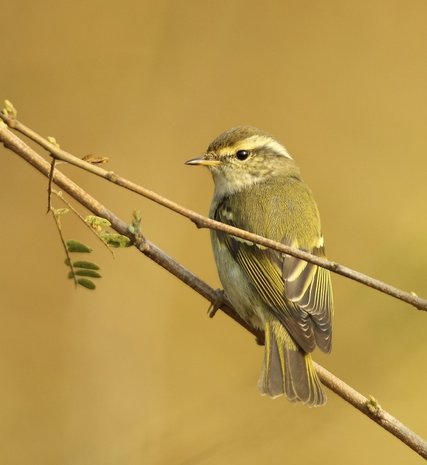 Yellow-browed Warbler
Yellow-browed Warbler
There is one other site that I often visit before entering the forest reserve, This is Tai Po Kau Park, a five-minute walk from the car park in the direction of Sha Tin (not marked on the map). This small ornamental park can be good for birds, especially early in the morning. The ubiquitous Red-whiskered Bulbul is the most obvious bird, but common resident species that I often see here include both minivets, Blue-winged Minla, Rufous-capped Babbler, Velvet-fronted Nuthatch, Yellow-cheeked Tit and Black-throated Laughingthrush. At certain times of the year, Great Barbet might be seen. Hair-crested and Ashy Drongos are regular in winter, as is Black-winged Cuckooshrike. Thrushes and Red-flanked Bluetail might also be found during this period. Migrant flycatchers and warblers may turn up in spring.
GETTING THERE
Tai Po Kau forest reserve is located in the central New Territories along Tai Po Road between Tai Po and Sha Tin. Take the MTR to Tai Po Market MTR on the East Rail line. From there it is easy to get a green taxi to the forest. Alternatively, take green minibus 28K from outside the station; this passes the reserve as it goes along Tai Po Road to Sha Tin.
The above account is adapted from my book “Hong Kong Nature Walks: The New Territories”.
All text and photographs are © David Diskin
The above account is adapted from my book “Hong Kong Nature Walks: The New Territories”.
All text and photographs are © David Diskin
